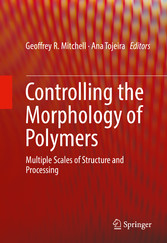Search and Find
Service
More of the content

Controlling the Morphology of Polymers - Multiple Scales of Structure and Processing
Preface
8
Contents
12
Chapter 1: Scales of Structure in Polymers
14
1.1 Introduction
14
1.2 Types of Bonds
14
1.3 Types of Polymers
15
1.4 Types of Materials
17
1.4.1 Thermoplastics
18
1.4.2 Thermosets
18
1.4.3 Composites, Micro-Fillers, Nano-Fillers
19
1.5 Types of Order
20
1.5.1 Crystalline
20
1.5.2 Liquid Crystalline
20
1.5.3 Amorphous
21
1.5.4 Blends and Mixtures
21
1.6 Structuring Processes
21
1.6.1 Crystallization
21
1.6.1.1 Lamellae to Spherulites
22
1.6.1.2 Crystal Growth Rates
23
1.6.1.3 Primary and Secondary Nucleation
24
1.6.1.4 Folding Theories
25
1.6.1.5 Computer Modelling Theories
26
1.6.1.6 The Bell Curve
26
1.6.1.7 Nucleation
27
1.6.1.8 Crystallization in Practice
27
1.6.1.9 Crystallization and Orientation
28
1.6.2 Microphase Separation and Block Copolymers (BCP)
28
1.6.2.1 Photonic Crystals
32
1.6.2.2 Micelles
32
1.6.3 Phase Separation Mixtures
33
1.6.4 Phase Separation on Reaction
35
1.7 Large-Scale Processes
36
1.8 Summary
37
References
37
Chapter 2: Evaluating Scales of Structures
42
2.1 Introduction
42
2.2 Indirect Methods
43
2.2.1 Differential Scanning Calorimetry
43
2.2.1.1 Reorganization and `Morphological Melting´
46
2.2.1.2 Thermal Fractionation
47
2.2.2 Dynamics
49
2.2.3 Spectroscopy
49
2.3 Imaging Methods
50
2.3.1 Light Microscopy
50
2.3.1.1 Polarized Optical Microscopy (POM)
52
2.3.1.2 Use of Tint Plates
53
2.3.1.3 Circularly Polarized Light
54
2.3.1.4 Phase Contrast Microscopy
55
2.3.1.5 Interference Microscopy (Nomarski)
56
2.3.1.6 Ancillary Techniques
58
2.3.2 Scanning Electron Microscopy
58
2.3.2.1 Contrast
59
2.3.2.2 Sandwiching and Embedding Techniques
60
2.3.3 Etching
61
2.3.4 Transmission Electron Microscopy
63
2.3.4.1 Inducing Contrast
63
2.3.5 Atomic Force Microscopy
66
2.4 Scattering Methods
66
2.4.1 X-Ray Scattering
67
2.4.1.1 Small Angle X-Ray Scattering
67
2.4.1.2 Wide Angle X-Ray Scattering
68
2.4.1.3 SAXS/WAXS Instruments
70
2.4.2 Neutron Scattering
71
2.4.2.1 Small Angle Neutron Scattering
72
2.4.2.2 Broad Q Neutron Diffraction
72
2.4.2.3 Neutron Scattering Instruments
74
2.5 Summary
76
References
76
Chapter 3: Crystallization in Nanocomposites
81
3.1 Introduction
81
3.2 Templating
82
3.2.1 Linear Nucleation
82
3.3 Crystallization and Flow
84
3.4 Nanoparticles
87
3.4.1 Introduction
87
3.4.2 Carbon Nanotubes
88
3.4.3 Nanoclay
93
3.5 Nanocomposites with Carbon Nanotubes
98
3.5.1 Nanocomposites with Halloysites
100
3.5.2 Nanocomposites with Clay Platelets
101
3.5.3 Nanocomposites with Graphene
104
3.5.4 Summary
106
References
107
Chapter 4: Theoretical Aspects of Polymer Crystallization
113
4.1 Introduction
113
4.2 Thermodynamics of Polymer Crystallization
114
4.2.1 Basic Concepts
114
4.2.2 Statistical Thermodynamics of Polymer Crystallization
120
4.2.3 Properties of Equilibrium Melting Points
122
4.2.3.1 Interaction Parameters
122
4.2.3.2 Molecular Weights
123
4.2.3.3 Comonomer Contents in Random Copolymers
125
4.2.4 Phase Diagrams of Polymer Solutions
126
4.3 Kinetics of Polymer Crystallization
129
4.3.1 Crystal Nucleation
129
4.3.2 Crystal Growth
137
4.3.2.1 Secondary Nucleation Models
137
4.3.2.2 Other Non-nucleation Models
144
4.3.3 Crystal Annealing
147
4.4 Summary
149
References
150
Chapter 5: Controlling Morphology Using Low Molar Mass Nucleators
156
5.1 Introduction
156
5.2 Organic Gelators
158
5.3 Synthesis of Sorbitol Derivatives
159
5.4 DBS in Polymers
160
5.5 DBS Directing Crystallisation
166
5.6 Model of Directed Crystallisation
169
5.7 Summary
170
References
171
Chapter 6: Crystallization in Nanoparticles
173
6.1 Introduction
173
6.2 Generation of Polymer Nanoparticles
175
6.3 Modification of the Crystalline Morphology by Confinement into Nanoparticles
177
6.3.1 Crystallization in Nanoparticles
180
6.3.2 From Polymer Nanoparticles to Polymer Nanocrystals
183
6.4 Summary
185
6.5 Methods
186
Bibliography
186
Chapter 7: Controlling Morphology in 3D Printing
191
7.1 Introduction
191
7.1.1 Light-Based Technologies
193
7.1.2 Print-Based Technologies
194
7.1.3 Extrusion-Based Technologies: Melt or Solution
194
7.1.3.1 Fused Deposition Modelling/Fused Filament Fabrication
194
7.2 FDM/FFF Feedstock Materials
195
7.3 Parameters in FDM/FFF 3D Printers
197
7.3.1 Surface
198
7.3.1.1 Layer Thickness
198
7.3.1.2 Part Orientation
198
7.3.2 Layer and Cross-Section
199
7.3.2.1 Gap Between Filaments
199
7.3.2.2 Layer Patterning
201
7.3.2.3 Materials Properties
201
7.3.3 Filaments
203
7.4 Case Study 1: Feedstock Material
204
7.5 Case Study 2: Deposition Speed
206
7.6 Case Study 3: Feed Roller Velocity/Screw Rotation Velocity
208
7.7 Case Study 4: Extrusion Temperature
211
7.8 Summary
214
References
214
Chapter 8: Electrically Conductive Polymer Nanocomposites
218
8.1 Introduction
218
8.2 Percolation Theory
219
8.2.1 Electrical Conductivity Mechanisms
223
8.3 Filler Effects on Polymer Nanocomposites
229
8.3.1 Aspect Ratio
229
8.3.2 Polydispersity
230
8.3.3 Orientation
232
8.3.4 Dispersion and Filler Localisation
233
8.3.5 Rheology and Mechanical Properties
236
8.3.6 Crystallisation and Morphology
239
8.4 Summary
241
References
242
Chapter 9: Nanodielectrics: The Role of Structure in Determining Electrical Properties
246
9.1 Introduction
246
9.1.1 Nanotechnology
247
9.1.2 Nanocomposites: Scales of Structure
248
9.2 Nanodielectric Properties
249
9.2.1 Surface Electrical Properties of Nanodielectrics
249
9.2.1.1 Resistance to Corona and Surface Discharges
249
9.2.1.2 Degradation of Nanocomposites: Mechanisms
250
9.2.2 Bulk Electrical Properties of Nanodielectrics
252
9.2.2.1 Breakdown Strength
252
9.2.2.2 Permittivity
254
9.2.3 Nanoparticles as Structural Modifiers
258
9.3 Theories and Models
260
9.3.1 Miscibility and Dispersion
260
9.3.2 Interfaces and Interphases
262
9.3.3 From Composition to Properties
263
9.4 Advanced Dielectrics Through Morphological Design
264
9.4.1 Polyethylene Blends
265
9.4.2 Polypropylene Blends
267
9.5 Summary
269
References
269
Chapter 10: Block Copolymers and Photonic Band Gap Materials
272
10.1 Introduction
272
10.1.1 Phase Behaviour of Block Copolymers
273
10.2 Photonic Band Gap Materials
276
10.3 Synthesis of Block Copolymers
280
10.3.1 Characterisation of Photonic Band Gap Materials
287
10.3.2 Extending to Longer Wavelengths
288
10.4 Conclusion
291
References
291
Chapter 11: Relationship Between Molecular Configuration and Stress-Induced Phase Transitions
295
11.1 Introduction
295
11.2 Isotactic Polypropylene Samples
298
11.3 Structural Analysis and Mechanical Properties
299
11.4 Optical and Atomic Force Microscopy
304
11.5 Stress-Induced Phase Transitions in Unoriented Films
307
11.6 Structural Analysis at Microscopic Length Scale
312
11.7 Structural Analysis at Lamellar Length Scale
318
11.8 Determination of Damage Effect
324
11.9 Concluding Remarks
328
References
331
Chapter 12: Summary
336
References
337
Index
338
All prices incl. VAT












